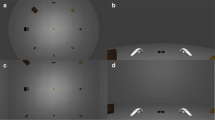Abstract
The current study examined the potential influence of existing spatial knowledge on the coding of new spatial information. In the Main experiment, participants learned the locations of five objects before completing a perspective-taking task. Subsequently, they studied the same five objects and five additional objects from a new location before completing a second perspective-taking task. Task performance following the first learning phase was best from perspectives aligned with the learning view. However, following the second learning phase, performance was best from the perspective aligned with the second view. A supplementary manipulation increased the salience of the initial view through environmental structure as well as the number of objects present. Results indicated that the initial learning view was preferred throughout the experiment. The role of assimilation and accommodation mechanisms in spatial memory, and the conditions under which they occur, are discussed.







Similar content being viewed by others
Notes
Depiction of this data suggested the possibility of a sawtooth pattern of performance that is indicative of an intrinsic reference frame (Mou & McNamara, 2002). An intrinsic contrast (contrast weights with a minimum at 0° = −1.625, 0.375, −0.625, 1.375, −0.625, 1.375, −0.625, 0.375; Greenauer and Waller 2008) was fit to this data and was found to describe the data well, F(1, 17) = 5.79, p = .028. However, although this contrast was able to account for 21.50 % of the variance associated with imagined heading, unlike the quadratic contrast it left a significant amount of variance unaccounted for, F(6, 119) = 3.82, p = .003.
References
Greenauer, N., & Waller, D. (2008). Intrinsic array structure is neither necessary nor sufficient for nonegocentric coding of spatial layouts. Psychonomic Bulletin & Review, 15, 1015–1021.
Greenauer, N., & Waller, D. (2010). Micro- and macroreference frames: specifying the relations between spatial categories in memory. Journal of Experimental Psychology. Learning, Memory, and Cognition, 36, 938–957.
Hintzman, D. L., O’Dell, C. S., & Arndt, D. R. (1981). Orientation in cognitive maps. Cognitive Psychology, 13, 149–206.
Kelly, J. W., & Avraamides, M. N. (2011). Cross-sensory transfer of reference frames in spatial memory. Cognition, 118, 444–450.
Kelly, J. W., & McNamara, T. P. (2010). Reference frames during the acquisition and development of spatial memories. Cognition, 116, 409–420.
Keppel, G., & Wickens, T. D. (2004). Design and analysis: A researcher’s handbook. Upper Saddle River: Pearson Prentice Hall.
Levin, J., & Neumann, E. (1999). Testing for predicted patterns: When interest in the whole is greater than in some of its parts. Psychological Methods, 4, 44–57.
Meilinger, T., Berthoz, A., & Wiener, J. M. (2011). The integration of spatial information across different viewpoints. Memory & Cognition, 39, 1042–1054.
Mou, W., Fan, Y., McNamara, T. P., & Owen, C. B. (2008). Intrinsic frames of reference and egocentric viewpoints in scene recognition. Cognition, 106, 750–769.
Mou, W., Liu, X., & McNamara, T. P. (2009). Layout geometry in encoding and retrieval of spatial memory. Journal of Experimental Psychology. Learning, Memory, and Cognition, 35, 83–93.
Mou, W., & McNamara, T. P. (2002). Intrinsic frames of reference in spatial memory. Journal of Experimental Psychology. Learning, Memory, and Cognition, 28, 162–170.
Mou, W., McNamara, T. P., Valiquette, C. M., & Rump, B. (2004). Allocentric and egocentric updating of spatial memories. Journal of Experimental Psychology. Learning, Memory, and Cognition, 30, 142–157.
Mou, W., Zhao, M., & McNamara, T. P. (2007). Layout geometry in the selection of intrinsic frames of reference from multiple viewpoints. Journal of Experimental Psychology. Learning, Memory, and Cognition, 33, 145–154.
Rieser, J. J. (1989). Access to knowledge of spatial structure at novel points of observation. Journal of Experimental Psychology. Learning, Memory, and Cognition, 15, 1157–1165.
Rosenthal, R., & Rosnow, R. L. (1985). Contrast analysis: Focused comparisons in the analysis of variance. Cambridge: Cambridge University Press.
Roskos-Ewoldsen, B., McNamara, T. P., Shelton, A. L., & Carr, W. (1998). Mental representations of large and small spatial layouts are orientation dependent. Journal of Experimental Psychology. Learning, Memory, and Cognition, 24, 215–226.
Shelton, A. L., & McNamara, T. P. (1997). Multiple views of spatial memory. Psychonomic Bulletin & Review, 4, 102–106.
Shelton, A. L., & McNamara, T. P. (2001). Systems of spatial reference in human memory. Cognitive Psychology, 43, 274–310.
Shelton, A. L., & McNamara, T. P. (2004). Spatial memory and perspective taking. Memory & Cognition, 32, 416–426.
Valiquette, C. M., McNamara, T. P., & Labrecque, J. S. (2007). Biased representations of spatial structure of navigable environments. Psychological Research, 71, 288–297.
Waller, D., Lippa, Y., & Richardson, A. R. (2008). Isolating observer-based reference directions in human spatial memory: Head, body, and self-to-array axis. Cognition, 106, 157–183.
Yamamoto, N., & Shelton, A. L. (2005). Visual and proprioceptive representations in spatial memory. Memory & Cognition, 33, 140–150.
Acknowledgments
This research was supported in part by a grant (European Research Commission grant OSSMA 206912) to the third author. We thank Marios Theodorou, Yianna Armosti, Margarita Panayiotou, and Christina Michael for their assistance in conducting these experiments.
Author information
Authors and Affiliations
Corresponding author
Rights and permissions
About this article
Cite this article
Greenauer, N., Mello, C., Kelly, J.W. et al. Integrating spatial information across experiences. Psychological Research 77, 540–554 (2013). https://doi.org/10.1007/s00426-012-0452-x
Received:
Accepted:
Published:
Issue Date:
DOI: https://doi.org/10.1007/s00426-012-0452-x




